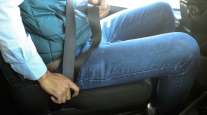Senior Reporter
Nearly 1,300 CMVs Taken Out of Service on Surprise Brake Safety Day

[Stay on top of transportation news: Get TTNews in your inbox.]
Commercial vehicle inspectors took 1,290 CMVs, or 14.1% of those inspected, out of service with critical brake-related violations on a special unannounced brake safety day operation conducted April 27, the Commercial Vehicle Safety Alliance announced June 22.
A total of 9,132 CMVs were inspected during the one-day inspection and enforcement initiative in the U.S. and Canada.
In addition, 1,534 brake hose/tubing violations were recorded by inspectors.
On April 27, 46 jurisdictions in Canada and the U.S. removed 1,290 CMVs with brake-related critical vehicle inspection item violations from Canadian and American roadways. That’s 14.1% of the 9,132 commercial motor vehicles inspected that day. https://t.co/xM70vrKINi pic.twitter.com/IalzEduVC0 — CVSA (@CVSA) June 22, 2022
On April 1, CVSA updated the North American Standard Out-of-Service Criteria to amend Category 4 to make any tubing/hose damage resulting in the fabric/steel braid reinforcement ply being frayed, damaged or cut an out-of-service violation.
Compared with last year, the new Category 4 brake hose/tubing chafing violations, as a portion of total brake hose/tubing chafing violations, increased from 17% to 18%, even when accounting for what amounts to combining of categories 4 and 5 from 2021.
The inspection effort focused specifically on brake systems and components on commercial motor vehicles.
Next month, commercial motor vehicle inspectors in the U.S., Canada and Mexico will be conducting this year’s Brake Safety Week.
During Brake Safety Week, from Aug. 21-27, inspectors will conduct their usual North American Standard Level I and V inspections, and capture and report brake-related data to CVSA. This year’s focus will be on total inspections and brake-related out-of-service violations, and inspectors also will capture and provide data on brake hose/tubing chafing violations.
This year’s Brake Safety Week is Aug. 21-27. CVSA created a printable 2022 Brake Safety Week flyer with 10 tips for drivers/operators to avoid brake hose or tubing violations. #BrakeSafetyWeek https://t.co/qQSZqYlxjN pic.twitter.com/9GZdjmXUxG — CVSA (@CVSA) June 16, 2022
The results will be released in the fall.
Brake-related violations continue to account for the largest percentage of all out-of-service vehicle violations cited during roadside inspections. According to last year’s three-day International Roadcheck data, brake systems and brake adjustment violations accounted for 38.9% of all vehicle out-of-service violations — the most of any category of vehicle violations.
To prepare for the event, CVSA recommends that motor carriers conduct proactive vehicle maintenance in advance of the week, and reminds drivers and carriers about the importance of proper brake maintenance and vehicle pre-trip and post-trip inspections.

The Transport Topics Top 100 For-Hire Carriers list ranks the largest players in the trucking industry. In this episode, the makers of this year’s list discuss how it came together and what it means for the supply chain. Tune in above or by going to RoadSigns.TTNews.com.
During the brake portion of a vehicle inspection, inspectors will look for missing, nonfunctioning, loose, contaminated or cracked parts on the brake system. They also will check for nonmanufactured holes (such as rust holes and holes created by rubbing or friction) and broken springs in the spring brake housing section of the parking brake.
They also will listen for audible air leaks around brake components and lines, and ensure the air system maintains air pressure between 90-100 pounds per square inch.
Inspectors will look for S-cam flip-over and measure pushrod travel, and that slack adjusters are the same length from center of S-cam to center of clevis pin, and air chambers on each axle are the same size.
They also will inspect required brake-system warning devices, such as ABS malfunction lamps and low-air-pressure warning devices and ensure the breakaway system is operable on the trailer as well as inspect the tractor protection system, including the bleed-back system on the trailer.
“Poorly maintained brake systems can reduce the braking capacity and stopping distance of large trucks and motorcoaches, which poses a serious risk to driver and public safety,” said the CVSA president, Capt. John Broers with the South Dakota Highway Patrol. “In those split-second emergency situations, the proper functionality of the brake systems on large commercial motor vehicles is crucial.”
Want more news? Listen to today's daily briefing below or go here for more info:




